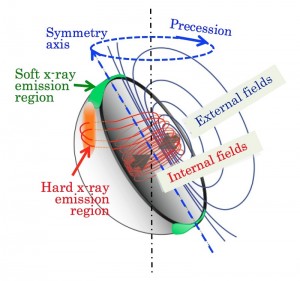The strongest magnetic stars are possibly deformed Wobbling of a magnetar detected with Suzaku

Neutron stars, the densest objects in the Universe, are composed almost entirely of neutrons and are as heavy as the Sun, but have radii of only 10 km. The gravitational attraction on the surface of a neutron star is exceeded only by that of black holes, and they usually possess strong magnetic fields as well. A subclass of neutron stars with the strongest magnetic fields, called magnetars, are thought to emit X-ray photons by consuming their huge magnetic energies.

© 2014 Toshio Nakano and Kazuo Makishima.
An illustration of magnetic-field configuration of a magnetar. Dark blue curves indicate dipolar magnetic field lines that are externally observable, while red curves indicate toroidal field lines confined within the star. The dark-blue and red field lines cause oblate and prolate deformation, respectively. Possible regions of the soft and hard X-ray emission are indicated in green and orange, respectively.
A research group in the Department of Physics of the Graduate School of Science, the University of Tokyo, led by Professor Kazuo Makishima, collaborated with a research group at RIKEN (including a NASA-affiliated researcher) and used JAXA’s Cosmic X-ray Satellite Suzaku, to observe the magnetar 4U 0142+61. The researchers confirmed that pulses of soft (low-energy) X-rays from this object are regularly emitted at its rotation period every 8.69 sec, while hard (high-energy) X-ray pulses are subject to small arrival-time modulations with a period of 15 hours. This suggests that the star is performing free precession, namely, wobbling of its symmetry axis, and is very slightly elongated by just 0.01% from the spherical along the axis, creating a lemon shape. This, coupled with a suggested displacement of the hard X-ray emission region from the rotation axis, is thought to have caused the pulse-phase modulation. The lack of such a modulation in soft X-rays can be explained by assuming that these lower-energy photons are emitted from regions close to the rotation axis. The implied aspheric deformation of this extremely dense and high-gravity object, in turn, suggests the presence of extremely strong toroidal magnetic fields, up to 1012 Tesla, residing inside this neutron star. This strength is close to a theoretically conceivable upper limit. The present work is the first to observationally estimate the strength of such internal magnetic fields of neutron stars.
Press release (Japanese)
Paper
Makishima, K., Enoto, T., Hiraga, J. S., Nakano, T., Nakazawa, K., Sakurai, S., Sasano, M., and Murakami, H.,
“Possible Evidence for Free Precession of a Strongly Magnetized Neutron Star in the Magnetar 4U 0142+61”,
Physical Review Letters Vol. 112, Issue 17, id.171102 (2014), 2014/04/30 (Japan time), doi: 10.1103/Phys RevLett.112.171102
Article link (Publication, UTokyo Repository)
Links
Department of Physics, Graduate School of Science
Makishima-Nakazawa Laboratory, Department of Physics, Graduate School of Science
Research Center for the Early Universe, Graduate School of Science
Tamagawa High-Energy Astrophysics Laboratory, RIKEN Nishina Center






